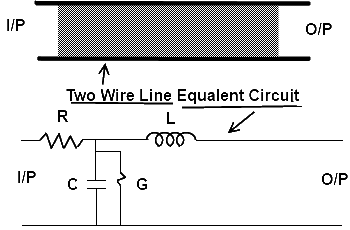Distributed Line Constant
The primary line constants are parameters that describe the characteristics of copper (or other conductive materials) transmission lines in terms of the physical electrical properties of the line. The primary line constants are only relevant to copper lines and are to be contrasted with the secondary line constants, which can be derived from them and are more generally applicable. The secondary line constants can be used, for instance, to compare the characteristics of a waveguide to a copper line, whereas the primary constants have no meaning for a waveguide
Primary Line Constant
Equivalent Circuit

Inductance
When AC input is applied to the transmission line, its inductive reactance (XL) increases with an increase in frequency. As the transmission line is made up of millions of small particles, the chain of those particles makes the transmission line behave as an inductor.
The presence of this inductance provides opposition to the flow of alternating current. This inductance is also one of the primary line constants and is measured in H/Km (Henry/kilometer).
Capacitance
As the transmission line is made up of two conducting wires with dielectric in between, capacitance is present in the transmission lines. The dielectric material used in transmission lines may be air, plastic, rubber, polystyrene, polyethylene, etc. The capacitance of the transmission line is measured in f/km.
Conductance
The two wires of the transmission line are separated from each other with the help of insulating material. As each insulating material has more or less conductive effects, conductance is also one of the primary line constants. It is measured in mho/km.
Resistance
As the transmission line is made of conducting wire, and we know that every wire has some specific resistance according to the type of material used, the transmission line will also have loop resistance, which is known as one of the primary line constants. It is measured in ohms per kilometer (Ω/km)
Surge or Characteristics Impedance Zo
If the transmission line is made infinitely long, and we measure its input impedance from the source, this input impedance of the infinitely long transmission line is known as its characteristic impedance. It is abbreviated as Zo and is also known as surge impedance.
The formula for Surge or Characteristics Impedance Zo
There are The following formulas used to measure the characteristics and impedance of transmission lines.
Here L stands for inductance per unit length of transmission line C stands for capacitance per unit length of transmission line.
Here Z stands for impedance of the transmission line and y stands for admittance of the transmission line. (Admittance is opposite to the impedance)
Provided that the transmission line is infinitely long.
J stands for angular difference or a large difference
W stands for 2πf
G stands for Conductance
